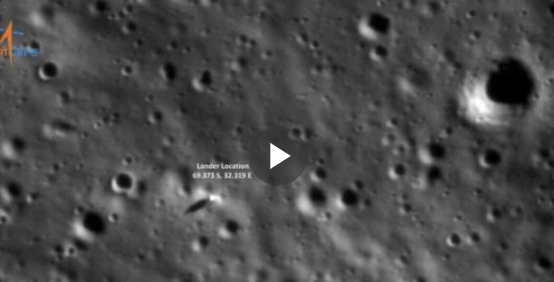Chandrayaan-3, India’s latest lunar mission, has made groundbreaking discoveries about the Moon, particularly in the previously unexplored south pole region. Here are some of the most significant findings:
Evidence of an Ancient Magma Ocean: Chandrayaan-3’s data supports the Lunar Magma Ocean theory, suggesting that the Moon’s surface was once covered by a vast ocean of molten rock. This magma ocean likely existed around 4.5 billion years ago during the Moon’s early formation. The rover Pragyan detected remnants of ferroan anorthosite, a mineral that formed as the Moon’s surface cooled, providing direct evidence of this molten history.
Scientists have discovered that the Moon’s south pole was once covered by an ocean of molten rock, reinforcing a longstanding theory about the Moon’s formation. This finding comes from India’s Chandrayaan-3 mission, which made history by landing on the lunar south pole in August 2023.
Ancient ocean of magma found on Moon south pole#Moon pic.twitter.com/vKePNv8sQU
— B.C. Begley (@BC_News1) August 22, 2024
The discovery lends significant support to the Lunar Magma Ocean theory, which posits that the Moon’s surface was formed from a vast ocean of magma about 4.5 billion years ago. According to this theory, as the Moon cooled, a lighter mineral called ferroan anorthosite floated to the surface, creating the Moon’s initial crust. The Chandrayaan-3 mission found evidence of this mineral at the Moon’s south pole, adding new weight to the theory.
Dr. Santosh Vadawale, a co-author of the study published in Nature and a researcher at the Physical Research Laboratory, emphasized that these observations significantly strengthen our understanding of the Moon’s early evolution. Prior to this mission, evidence supporting the existence of magma oceans primarily came from mid-latitude regions explored during the Apollo missions.
The Chandrayaan-3 mission, controlled by a team led by Dr. Vadawale, marked a pioneering exploration of the Moon’s south pole. The mission’s lander, Vikram, made a successful soft landing, deploying a rover named Pragyaan. Over the course of ten days, Pragyaan traversed the lunar surface, collecting crucial data at a latitude of 70 degrees south. The rover, designed to endure extreme temperature variations, used an alpha particle X-ray spectrometer to analyze the minerals in the Moon’s soil. This instrument excites atoms and measures the resulting energy to identify the mineral composition of the lunar surface.
ISRO’s Chandrayaan-3 data confirms Moon’s surface was once covered in an ocean of magma
Data from 🇮🇳 #ISRO‘s Chandrayaan-3 mission has bolstered the hypothesis that the Moon once had a “magma ocean,” according to a study published in Nature.
This conclusion stems from the… pic.twitter.com/4pywzLBHlH
— Resonant News🌍 (@Resonant_News) August 22, 2024
In addition to uncovering remnants of the magma ocean, the team also found evidence of a massive meteorite impact that occurred around four billion years ago. This impact is believed to have created the South Pole–Aitken basin, one of the largest craters in the solar system, stretching 2,500 kilometers across. Though the basin lies about 350 kilometers from where Pragyaan explored, scientists detected magnesium on the surface, which they suspect was propelled from deep within the Moon by the impact.
Professor Anil Bhardwaj, director of India’s Physical Research Laboratory, explained that the asteroid impact likely excavated material from the Moon’s deeper layers, scattering it across the surface. This discovery adds to the wealth of scientific data gathered during the Chandrayaan-3 mission, which also aims to identify potential ice water deposits at the lunar south pole—a finding that could be pivotal for future human exploration.
#ISRO (Chandrayaan-3) has mapped the composition of lunar surface at the high-latitude southern hemisphere for the first time and revealed it’s primarily composed of ‘magma’ or ferroan anorthosite (FAN) : Nature Science Journal pic.twitter.com/opOXzLySmo
— News IADN (@NewsIADN) August 22, 2024
India is planning another lunar mission, set for launch in 2025 or 2026, with the ambitious goal of collecting and returning samples from the Moon’s surface to Earth for further analysis. This continued exploration could significantly advance our understanding of the Moon and support the vision of establishing a human presence on its surface.
More Info
Geological Composition: The mission revealed that the lunar south pole region contains materials such as magnesium and olivine, typically found deep within the Moon. These materials are believed to have been brought to the surface by a massive meteorite impact that created the South Pole–Aitken basin, one of the largest craters in the solar system.
Surface Analysis: Using an alpha particle X-ray spectrometer, Chandrayaan-3 conducted in-depth analysis of the lunar soil, identifying various minerals and confirming the presence of chemical remnants from the ancient magma ocean. This analysis is crucial for understanding the Moon’s geological history and could guide future lunar exploration efforts.
Meteorite Impact Evidence: The mission also uncovered signs of a massive meteorite impact that may have exposed deeper layers of the Moon’s crust. This impact likely played a significant role in shaping the geological features of the lunar south pole.
These findings not only enhance our understanding of the Moon’s history but also have implications for future lunar exploration, including potential missions aimed at returning samples from these ancient regions (Business Today) (Stock Market News).
Major Points:
- Scientists discovered that the Moon’s south pole was once covered in molten rock, supporting the Lunar Magma Ocean theory.
- India’s Chandrayaan-3 mission found evidence of ferroan anorthosite, a mineral that formed the Moon’s early surface, at the south pole.
- The mission also uncovered signs of a massive meteorite impact that created the South Pole–Aitken basin, one of the largest craters in the solar system.
- Magnesium from the Moon’s deeper layers was detected on the surface, likely thrown up by the ancient impact.
- India plans to launch another lunar mission by 2026, aiming to return samples from the Moon’s surface to Earth for further analysis.
RM Tomi – Reprinted with permission of Whatfinger News



